
BaFá BaFá is a face-to-face learning simulation (game), invented by Dr. R. Garry Shirts in 1974,[1][2][3] who also invented StarPower, and is published by Simulation Training Systems, Inc. The simulation is intended to improve participants' cross-cultural competence by helping them understand the impact of culture on the behavior of people and organizations. Participants experience "culture shock" by traveling to and trying to interact with a culture in which the people have different values, different ways of behaving and different ways of solving problems.
Versions
There are three versions, one for high schools, charities and universities,[4] one for middle school aged children called RaFá RaFá,[5] and a professional version[6] for business and government agencies.
Origin
Uses
BaFá BaFá is adaptable[9] and has been used in many different settings including with any groups that have different cultures, whether because of geographical location, political beliefs, race, organizational structure, mergers, sexual orientation, etc. Some examples of ways it has been used:
References
- ↑ Dukes, Richard L.; Fowler, Sandra M.; Dekoven, Bernie (October 2011). "R. Garry Shirts Simulation Gaming Exemplar". Simulation & Gaming. 42 (5): 545–570. doi:10.1177/1046878111424335. S2CID 62684075.
- ↑ Dekoven, Bernie (January 9, 2024). "Garry Shirts - A Life Created". Simulation & Gaming. 42 (5): 545.
- ↑ Gonzalez, Blanca (May 16, 2011). "Educational psychologist was pioneer in simulation training". The San Diego Union-Tribune. Retrieved April 30, 2015.
- ↑ "BaFa' BaFa' - Culture/Diversity for Schools & Charities". Simulation Training Systems. Retrieved June 24, 2015.
- ↑ "Rafa' Rafa' - Cultural Diversity Game". Simulation Training Systems. Retrieved June 24, 2015.
- ↑ "Professional BaFa' BaFa' - A Cross Culture/Diversity Simulation". Simulation Training Systems.
- ↑ Yellen, Ted M I; Hoover, Margaret W. "In-Country Experience: Navy Personnel Stationed in Greece". DTIC.mil. Archived from the original on June 20, 2015. Retrieved April 30, 2015.
- ↑ Bennett Dan Landis; Janet M. Bennett; Milton J., eds. (2004). Handbook of intercultural training (3rd ed.). Thousand Oaks, Calif.: Sage Publications. p. 20. ISBN 9780761923329. Retrieved April 30, 2015. (subscription required)
- ↑ Bennett Dan Landis; Janet M. Bennett; Milton J., eds. (2004). Handbook of intercultural training (3rd ed.). Thousand Oaks, Calif.: Sage Publications. pp. 62–63. ISBN 9780761923329. Retrieved April 30, 2015.
- ↑ Shirts, R. Garry. "BaFa' BaFa' Train The Trainer: When Used For Diversity" (PDF). Indiana State University. Indiana State University office of Diversity. Archived from the original (PDF) on April 12, 2015. Retrieved April 30, 2015.
- ↑ "Using Exercises and Simulations to Engage Students". Learn Center-Diversity and Inclusion-An Approach for Teaching Diversity-Triggers. University of Wisconsin, Whitewater. Archived from the original on February 26, 2015. Retrieved April 30, 2015.
- ↑ Persell, Caroline H; Gerdes, Jennifer. "Lesson Plan for NYU Intro to Sociology". New York University. Retrieved April 30, 2015.
- ↑ Bickley, Maureen. "Using an Experiential Simulation to Build Cross Cultural Understanding: a Qualitative Study of Graduate Students". Curtin University. Curtin University of Technology, Graduate School of Business. Retrieved April 30, 2015.
- ↑ Sauer, Janet; Sauer, Chris (2010). "Challenging Pre-service Teachers' Understanding of the Intersection of Disability and Cultural Diversity" (PDF). Journal of Praxis in Multicultural Education. 5 (1): 23–35. doi:10.9741/2161-2978.1030. Archived from the original (PDF) on March 4, 2016. Retrieved April 30, 2015.
- ↑ Yellen, Ted M. I. "The Cross-cultural Interaction Inventory: Development of Overseas Criterion Measures and Items That Differentiate Between Successful and Unsuccessful Adjusters" (PDF). DTIC.mil. Navy Personnel Research and Development Center. Archived (PDF) from the original on March 4, 2016. Retrieved April 30, 2015.
- ↑ Abbe, Ph.D, Allison; Gouge, Melissa. "Cultural Training for Military Personne l- Revisiting the Vietnam Era" (PDF). United States Army Combined Arms Center. Retrieved April 30, 2015.
- ↑ Blackburn, Donna S. (2009). "Nursing Students' Perceptions of a Simulation Game to Promote Cultural Sensitivity". Virginia Henderson International Nursing e-Repository. Archived from the original on March 5, 2016. Retrieved May 1, 2015.
- ↑ Cook, John; Martinez, Sergio. "Diversity Dimension Report" (PDF). University of Texas at Brownsville. Retrieved May 1, 2015.